Today’s workforce is highly multigenerational. Employees of different age have different expectations from their employers. However, it is not enough to consider only age when planning for your talent strategies in the workplace.
Highly complex workforce requires employers to adjust their talent strategies around employee engagement, communication, collaboration and performance.
In this blog, we will go over the importance of understanding your multigenerational workforce and best practices for engaging them while providing exceptional employee experience.
Engage your multigenerational workforce by adjusting your comms to the needs of your employees via the right IC tools
What Is a Multigenerational Workforce?
Multigenerational workforce is a term used to describe a situation in which there are multiple generations active and available on the labor market. Such phenomenon is being investigated and analyzed by many employers as they understand that these generations have different needs, wants and expectations from their employers.
Before we begin with the best practices for managing and engaging a multigenerational workforce, let’s go over the 5 working generations right now:
- Traditionalists – born in 1945 and before
- Baby Boomers – born between 1946 and 1964
- Generation X – born between 1965 and 1976
- Millennials – born between 1977 and 1995
- Generation Z – born in 1996 and after

10 Factors Impacting Your Multigenerational Workforce’s Engagement
Many employers who are trying to understand their multigenerational workforce are not sure about which aspect of the business they need to assess to satisfy their employees’ needs and preferences.
Before trying to adjust every aspect of the business based on those differences, it is also important to understand what your organization can do to satisfy what every employee expects today.
Let’s go over some of the most important factors employers should consider addressing in order to provide exceptional employee experience for their multigenerational workforce.
1. Leaders and Managers
Only 6% of organizations strongly agree that their leaders are equipped to lead a multigenerational workforce effectively. This shocking statistic shows that leaders have a long way to go in managing organizations with various generations.

As good leadership is one of the most important prerequisites for creating a positive workplace culture, the way they communicate with generations across their organizations is crucial. A great leader strives to understand their workforce. By making an effort to better understand each generation and support them, leaders can empower everyone to do their best work.
Moreover, research shows that leaders and managers are accountable for 70% of employee motivation and happiness. On the other hand, even though 3 in 4 employees see effective communication as the number one leadership attribute, less than 1 in 3 employees feel like their leaders communicate efficiently.
In order to engage your multigenerational workforce, your leaders and managers have to be authentic, consistent and approachable to everyone.
💡 Also learn about how leaders can build trust in the workplace.
2. Workplace visibility and transparency
Even though visibility and transparency may not be such a popular topic among older generations, millennials and generation Z employees want and expect full transparency from their employers.
As these two generations make the majority of today’s workforce, it is not surprising that many companies are now investing in becoming more employee-centric by providing full organizational transparency. To get the best out of your employees, encourage positive behaviours and make their professional experience a rewarding one, clear and usable information is key.
On the other side, employers are struggling to achieve better workforce visibility themselves. Moreover, 44% of employers rate their current level of workforce visibility as “partial”.

Hence, many organizations still don’t have a way to better understand their multigenerational workforce, their needs, preferences and the way they communicate and collaborate with each other.
💡 Learn about how our technology enables employers to gain valuable workforce insights.
3. Internal communications
Each different generation speaks its own ‘language’, responds differently to tone, type of content, medium and communication style. Getting your message across, reaching every employee and gaining their attention requires a deep understanding of your workforce.
Internal communicators may be the most affected departments when it comes to managing multigenerational workforce and driving employees’ engagement and productivity.
The way different generations prefer to communicate varies highly, from baby boomers being used to email and plain text, to millennials and gen Z preferring different communications channels and more engaging internal content such as videos, webinars and podcasts.
📹 Watch on demand. How To Use Video To Communicate With Employees.
Unfortunately, many IC professionals still don’t have a way to easily segment their internal audiences not just by their age, but also by their interests, job functions, locations and preferences. Yet, this is the only way to deliver content that is localized and that best resonates with the employees.
4. Access to information
Check out this fact…

Shocking isn’t it?
Many organizations are not even aware of how much time their employees spend on search for information. This problem is becoming even more evident now when remote work and dispersed workforce are on the rise.
📚 Also read: 14 IC Experts Share Their #1 Tip to Engage a Distributed Workforce.
Companies are trying to find ways to keep all the generations in the workplace well informed about the important company updates, safety tips, new policies and procedures. However, they are struggling to find and implement internal platforms with universal access to critical company information, resulting in frustrations among employees and drop in their engagement.
While older generations may be used to information search as their regular job, younger generations are highly digital. Therefore, they want all the information at their fingertips, accessible in a matter of seconds. On the other side, employers want to make sure that they can easily reach the right employees at the right time with the right content.
5. Mobile access
The way employees access information in the workplace and perform their tasks has changed significantly in the past few years. Organizations with multigenerational workforce have started to realize the importance of implementing mobile-friendly tools and technologies to drive productivity and enable interpersonal communication in the workplace.
Remote and in-office employees, non-wired, deskless employees, employees on the store, factory or hospital floors, all need technology that enables them to access critical information and stay connected with their co-workers. Without mobile access, this is quite impossible to achieve.
Consider millennials who are the largest generation in the US labor force and they are projected to represent 75% of the global workforce by 2025. They grew up in the technological age, they are always connected and can’t spend a few hours away from their smartphones. Moreover, they check their phones 150 times a day!

6. Technology (Digital Employee Experience)
While providing technology solutions that enable employees to do their jobs was enough in the past, this is not the case any more. Multigenerational workforce, with the majority of younger generations such as gen Z and millennials, expects much more than that.
They want their organization’s tech stack to work in the cloud and be highly integrated. For example, instead of having multiple communication channels such as email, Slack, Yammer, Microsoft Teams, document sharing tools and other, companies are looking for ways to consolidate them all into a single internal communications platform.
The ones who achieve that are much more likely to shape positive digital employee experience among all the generations in the workplace.
7. Company goals and strategy
No matter their age, all employees want to have a clear understanding of your business strategy and ultimate business goals. On the other hand, every employer wants to have their entire workforce aligned with their mission, vision and core company values.
When analyzing your multigenerational workforce, their scope and nature of work may be more important to understand than their age. Therefore, together with internal communications professionals, managers should work to create inspiring and motivating stories for their teams and departments.
Managers should also create designated communication channels to openly discuss goals and strategy with their subordinates.
8. Sense of purpose and share of voice
While older generations may not have a strong desire to continuously share their ideas, concerns and feedback, younger generations are expecting from employers to support their share of voice.

This is why we are seeing many organizations switching from traditional, one-way workplace communications to a more open, two-way communication approach. The ability to join important company conversations, and participate in decision making, create a much stronger sense of purpose among employees and result in higher employee engagement.
While older generations tend to stay with a company longer, younger generations may have greater expectations from their employer and are more likely to leave if their work isn’t personally fulfilling.
9. Knowledge sharing
Unlike older generations, young people think that knowledge should be shared and allowed to flow freely in the workplace. With the increase of skill gaps in the organizations, knowledge workers are becoming valuable assets who can transfer their knowledge to others.
Those organizations that manage to combine specialist and general knowledge across industries and expertise have a big competitive advantage. This is why employers are trying to find new ways to motivate employees from different generations to work together and share their knowledge with one another.
📚 Read on Organizational Knowledge: Challenges and Best Practices.
10. Brand ambassadorship
Having brand ambassadors in the workplace creates an immense advantage and opportunity for employers. However, not all generations are up for engaging in advocacy programs in their organizations.
While older generations may not be used to such initiatives, many millennials and gen Z employees want to be brand ambassadors. Yet, there are organizations that still don’t understand how to enable their employees to become advocates.

Besides just sharing inspirational stories and engaging content to employees internally, companies need to provide easy and intuitive ways for employees to share such information externally.
💡 Also check our Definitive Guide to Employee Advocacy.
Generational Differences Beyond Age
According to Deloitte, today’s workforce spans five generational categories, with generation Z, the United States’ largest demographic cohort at more than 90 million strong, about to join in.
The same research did a deep dive into the real differences between generations. Even though many companies are still focusing on age when trying to better understand their employees, there are many other workforce characteristics they need to consider.

Deloitte’s research proved that the gap among different generations around their career expectations is getting smaller and smaller. Many characteristics once associated with millennials only—from the desire to work for an employer that reflects their values and is open and transparent to the flexible working preferences—is now true across all generations.
“Despite the fact that 59 percent of our 2020 survey respondents agreed with the general statement that generational differences were expanding, when we dug deeper on attributes that relate to careers, we found the exact opposite in areas such as work-life flexibility, expectations of loyalty and job security, and expectations of advancement.” –Deloitte
Communication Differences Among Multigenerational Workforce
A study from Robert Half Management Resources revealed that communication is the most difficult aspect of managing a workplace.
Specifically, 30% of the executives surveyed said communication skills and preferences represent the greatest difference among employees from different generations.

Here are a few interesting findings from the research:
- Baby Boomers prefer face-to-face or phone conversations in the workplace.
- Members of generation X typically rely on email or texting to communicate with their co-workers.
- Millennials who now make up the largest part of the workforce prefer online means of communication. These mostly include modern employee communications solutions that mimic popular social media platforms.
- Similarly to millennials, generation Z employees prefer online means of communication, and they expect from employees to share more engaging and easy to consume types of content such as video.
- Millennials and gen Z employees are used to having personalized news feeds on social media. They build online communities, share insights on forums and look for recommendations on social media.
- Millennials appreciate authentic and fast communications; they value efficiency and a digital-first approach.
- Generation Z appreciate transparent and visual communications; they value video and a mobile-only approach.
Understanding these different audiences and having an effective internal communications strategy in place to communicate with different generations is essential in the modern workplace.
Your internal communications strategy should take into account multigenerational workforce communication styles. Different generations have different preferences around how they like to receive and consume information.
Today, employers really need to understand that, when it comes to workplace communications, there is no ‘one-size-fits-all’ approach. Corporate communications professionals are the ones that need to clearly define their employee personas in order to find the best ways to reach the right employees at the right time, via the right channels, with the right message relevant to what they do.
Here, emerging employee communications technology plays a big role. Rapid changes in such solutions in the past few years are completely reshaping the way employees expect to be informed in the workplace.
Therefore, if you stick to untailored email newsletters to communicate with your employees, you’re going to create a gap between your employees’ communication habits and the way you actually communicating with them.
Empower Your Multigenerational Workforce with the Right Technology
If your workforce is multigenerational, and if you are looking for an intuitive, engaging and modern employee communications solution, schedule a Haiilo demo today.
Haiilo enables organizations across the world to gain a better visibility of how different generations communicate and collaborate with each other.
Advanced, AI-powered technology empowers workplace communicators to better connect with employees and understand their engagement levels. It helps companies align employees with the ultimate business goals, drive employee ambassadorship and ensure that the right information always reaches the right employees at the right time.










